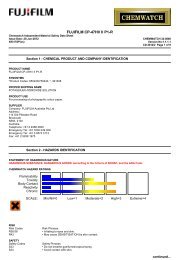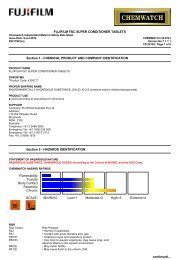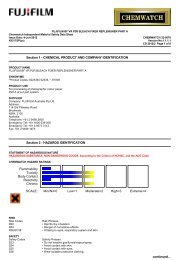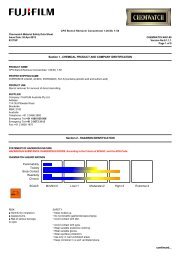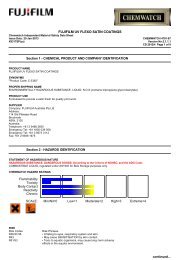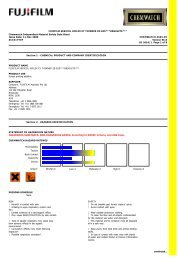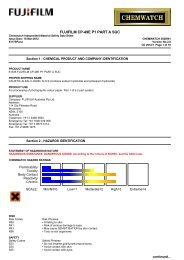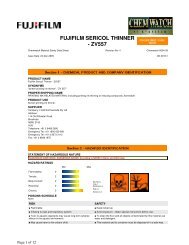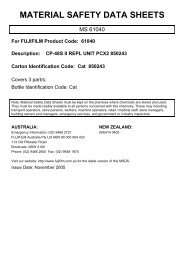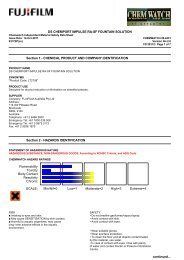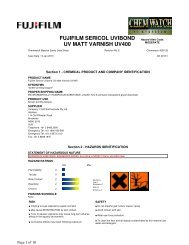CPS Haze Remover HV - FUJIFILM Australia
CPS Haze Remover HV - FUJIFILM Australia
CPS Haze Remover HV - FUJIFILM Australia
You also want an ePaper? Increase the reach of your titles
YUMPU automatically turns print PDFs into web optimized ePapers that Google loves.
<strong>CPS</strong> HAZE REMOVER <strong>HV</strong>Chemwatch Independent Material Safety Data SheetIssue Date: 25-Jul-2013 CHEMWATCH 4861-179317SP(cs)Version No:2.1.1.1CD 2013/2 Page 6 of 9Section 9 - PHYSICAL AND CHEMICAL PROPERTIESMelting Range (°C) Not Available Viscosity Not AvailableBoiling Range (°C) 100 Solubility in water (g/L) MiscibleFlash Point (°C) Not Applicable pH (1% solution) Not AvailableDecomposition Temp (°C) Not Available pH (as supplied) 11- 13Autoignition Temp (°C) Not Applicable Vapour Pressure (kPa) Not AvailableUpper Explosive Limit (%) Not Applicable Specific Gravity (water=1) 1.12Lower Explosive Limit (%) Not Applicable Relative Vapour Density Not Available(air=1)Volatile Component (%vol) Not Available Evaporation Rate Not AvailableSection 10 - STABILITY AND REACTIVITYCONDITIONS CONTRIBUTING TO INSTABILITY• Presence of incompatible materials.• Product is considered stable.• Hazardous polymerisation will not occur.For incompatible materials - refer to Section 7 - Handling and Storage.Section 11 - TOXICOLOGICAL INFORMATIONPOTENTIAL HEALTH EFFECTSACUTE HEALTH EFFECTSSWALLOWED■ The material can produce chemical burns within the oral cavity and gastrointestinal tract following ingestion.Accidental ingestion of the material may be damaging to the health of the individual.Ingestion of alkaline corrosives may produce burns around the mouth, ulcerations and swellings of the mucous membranes, profusesaliva production, with an inability to speak or swallow. Both the oesophagus and stomach may experience burning pain; vomitingand diarrhoea may follow. Epiglottal swelling may result in respiratory distress and asphyxia; shock can occur. Narrowing of theoesophagus, stomach or stomach valve may occur immediately or after a long delay (weeks to years). Severe exposure can perforatethe oesophagus or stomach leading to infections of the chest or abdominal cavity, with low chest pain, abdominal stiffness andfever. All of the above can cause death.Ingestion of hypochlorites may cause burning in the mouth and throat, abdominal cramps, nausea, vomiting, diarrhoea, pain andinflammation of the mouth and stomach, fall of blood pressure, shock, confusion,and delirium. Severe poisonings may leadconvulsion, coma and death.EYE■ The material can produce chemical burns to the eye following direct contact. Vapours or mists may be extremely irritating.If applied to the eyes, this material causes severe eye damage.Direct eye contact with corrosive bases can cause pain and burns. There may be swelling, epithelium destruction, clouding of thecornea and inflammation of the iris. Mild cases often resolve; severe cases can be prolonged with complications such aspersistent swelling, scarring, permanent cloudiness, bulging of the eye, cataracts, eyelids glued to the eyeball and blindness.Hypochlorite in pool water at concentrations of 1 ppm chlorine or less is non irritating to eyes if the pH is higher than 7.2(slightly alkaline); At lower pH sensation of stinging, smarting of eyes with transient reddening may occur but generally noinjury.Eye contact with a 5% hypochlorite solution may produce a temporary burning discomfort and slight irritation of the cornealepithelium with no injury.SKIN■ The material can produce chemical burns following direct contactwith the skin.Skin contact with alkaline corrosives may produce severe pain and burns; brownish stains may develop. The corroded area may besoft, gelatinous and necrotic; tissue destruction may be deep.Open cuts, abraded or irritated skin should not be exposed to this material.Contact may cause severe itchiness, skin lesions and mild eczema.A 5.25% solution of sodium hypochlorite applied to intact human skin for 4 hours and observed at 4, 24 and 48 hours resulted inexudation an slight sloughing of the skin on 4 of 7 subjects.Two patients were reported with chronic allergic dermatitis of the hand related to sensitisation to sodium hypochlorite as theactive component of laundry bleach.Entry into the blood-stream, through, for example, cuts, abrasions or lesions, may produce systemic injury with harmful effects.Examine the skin prior to the use of the material and ensure that any external damage is suitably protected.INHALED■ Inhaling corrosive bases may irritate the respiratory tract. Symptoms include cough, choking, pain and damage to the mucousmembrane. In severe cases, lung swelling may develop, sometimes after a delay of hours to days. There may be low blood pressure,a weak and rapid pulse, and crackling sounds.continued...



